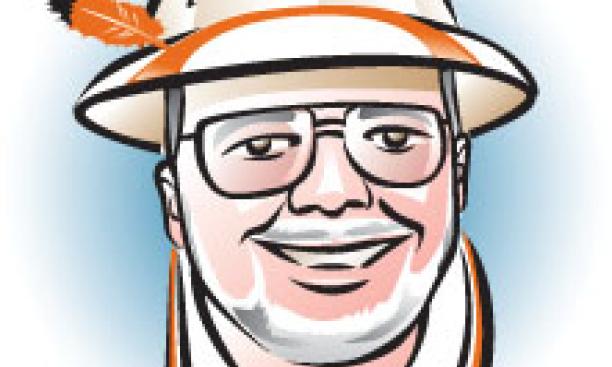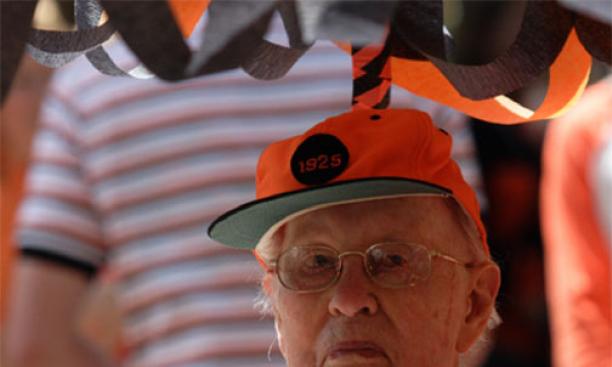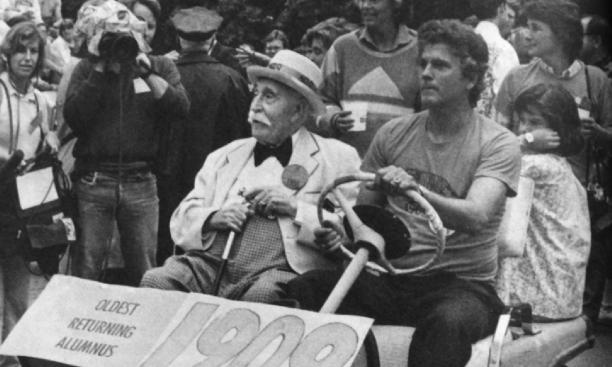


One thing I did try to impress on the visitors was the counterintuitive idea that the senior class is the true (double-secret) focus of Reunions. Very few colleges now do any such alumni gathering when the students are present, and that certainly means a more shallow experience for everybody. Clamping the kids into the alumni body and giving them (literally, in the P-rade) their marching orders prior to Commencement is a win-win-win for all concerned. Malcolm Warnock ’25 this year earned the Class of ’23 Cane as the senior returning alumnus in the P-rade (his fifth win, ’25’s 10th). When he was a senior, the Class of 1865 was marching, so he personally has seen 145 years of Princeton’s history. This is a powerful way to extend your own experience and perspective, to double your lifespan while having a cold one. A pretty fine trick, that.
The natural focus on the Old Guard (translation for the Ivy group: 66th reunion and up) at Reunions tends to overshadow the transitional 65th reunion, which certainly should be a point to paws (sic) and reflect. This year, the Class of ’44 decided not to go gentle into that good night, but instead to re-enact the Second World War, recognizing their 22 fallen classmates and taking great pains to bring back families of classmates, alive and dead. Their P-rade award-winning entry included a brown-shoe Army drill team, the Army band Pershing’s Own from Fort Myer, Va., and a slew of authentic jeeps that fought in Europe. Their total attendance of 350 more than tripled the existing record for a 65th reunion, one of those quantum bar-raising episodes that will have repercussions for many 65ths to come.
Reunions also plays unexpected tricks on your mind. Despite ’44’s Greatest Generation, it wasn’t the World War that occurred spontaneously to me this year, it was the Cold War. From John Foster Dulles 1908 to George Kennan ’25 to George Schultz ’42, many Tigers were closely woven into that epoch, and two of the most interesting marked milestones in 2009.
Hervey Stockman ’44 didn’t make it back for the great 65th celebration; his eyesight’s pretty much gone; he doesn’t travel that far anymore. And he’s traveled enough. While he was part of the class’s involvement in World War II (90 percent served in the military in some capacity) as a fighter pilot, his great trial came much later, after the rise of the Soviet and Chinese communist regimes led to a bilateral nuclear world. Recalled to active flying duty during Korea, the Cold War’s first hot salvo, he decided to stay in the service and put in a full career, and so ended up in Vietnam. His plane went down over Hanoi in 1966 (oddly, because of a botched flight plan, not enemy fire) and he ended up tortured in Hao Lo Prison, the infamous Hanoi Hilton, captive for 2,092 days. One of the finer – and most difficult to read – articles ever done for this magazine is Dan White ’65’s interview with Stockman (PAW, Oct. 9, 1973) after his release. Reflecting the wisdom of someone who knows himself, it shows startlingly both the courage and the debasement that war distills from the human psyche. Of course, we didn’t need Vietnam to show us that, nor did Stockman, who had 22 dead classmates already. The muddling of the war and anti-communist containment is such that historians will fight over its meaning long after those of us who were there are with the Old Guard in the sky. To Stockman, it was personal.
Meanwhile, the political controversies of the Cold War were barely less acrimonious (see J. Robert Oppenheimer h’66). And caught in the maelstrom of not one but two of them was the great Princeton alumnus, Judge Harold Medina 1909, who watched the P-rade for the first time just 100 years ago. A brilliant French language protégé of young Professor Christian Gauss, he went into the law on his mother’s advice (PAW, June 5, 1988), built a thriving New York career, then went onto the federal bench in 1947. He drew the Smith Act trial of the leaders of the American Communist Party in 1949, and for 11 months presided over a circus replete with fear (consider that the FBI had just named Helen Keller and Danny Kaye communists), innuendo, loaded meanings, and uncharted arguments. He kept things together sufficiently to make the cover of Time Magazine midway through the trial and tolerated little guff: in addition to the 11 defendants who were found guilty, five defense attorneys went to prison for contempt. Promoted to the federal circuit appeals bench in 1953, Medina served for 27 years, until he was 92. He became a Princeton trustee, and in that role along with Harold Helm ’20 was crucial in supporting President Dodds in the Cold War cause célèbre of 1956. The issue: allowing Alger Hiss, just released from prison for perjury in a supposed spy case, to make his first public address at the request of Whig-Clio (PAW, May 3, 1976). Among all the exercised parties to the white-hot debate on campus and in the world press, only Medina seemed concerned with the First Amendment; even Dodds was arguing only “student responsibility” – in other words, let them make their own mistakes. Medina and Helm held the day with the nervous trustees, Hiss spoke (boringly), and nobody remembered what all the fuss was about. In the academic world, Princeton’s reputation as a place of serious learning and intellectual inquiry skyrocketed.
After joining the Old Guard in 1975, Medina gradually became the poster boy for Reunions as well, his white walrus mustache, twinkly eye and (active!) judicial attitude forming an irresistible image for the youngsters. A survivor of the Cold War along with Hervey Stockman, he led the P-rade with the Class of ’23 Cane in 1985 and 1986, when he was 98. No one ever enjoyed it more.

